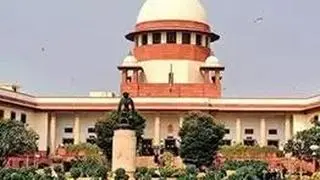Exactly a year after the ruling BJP scrapped Article 377, Prime Minister Narendra Modi’s participation on August 5 at the inauguration of the construction of Ram temple in Ayodhya is being marked as the symbolic end of the “politics of appeasement” and the beginning of cultural nationalism in India.
The BJP’s ideological affiliates have taken particular care to include symbolic representation of water and earth from places of Jain, Buddhist and Sikh religious importance as well as invite SC/ST and OBC members for the ceremony to obliterate caste stratifications in what is being hailed as the “beginning of a new India”.
Prayers for the “two-day Diwali” on August 4-5 in Ayodhya began at 10 am on Sunday with a ceremonial worship at the Hanuman Garhi temple. The Ayodhya Municipal Corporation plans to light 51,000 earthen lamps while Uttar Pradesh Chief Minister Yogi Adityanath has asked residents to light up their homes in keeping with the festive spirit.
The town is being painted with the auspicious yellow and saffron hues, especially from Saket Mahavidyalaya, where the Prime Minister is expected to land at 11.40 am on August 5, till Hanuman Garhi and Naya Ghat on the Saryu. The prayers having already begun for the inauguration ceremony, local priests say Modi will offer a special puja on Tuesday at 12.12 pm, which has been scheduled as the abhijeet nakshatra , or the most auspicious moment. About 1,11,000 laddoos are being prepared locally to be distributed at the conclusion of the puja.
Speaking to BusinessLine , Vishwa Hindu Parishad President Alok Kumar said the function at Ayohdya is the beginning of the reconstruction of an India that is confident of its Hindu identity.
Nehru’s ‘lopsided view’
“After Independence, Nehruji imposed his lopsided view of Hinduism on India. He was so extreme in his opposition to Hindutva that he advised the first President, Dr Rajendra Prasad, against participating in the inauguration of the Somnath temple. So, Indians, who had suffered a thousand years of inferiority and slavery, remained enslaved after Independence. What is happening in Ayodhya this Tuesday is the beginning of a new India that is confident of its Hindu identity,” he said.
Earth and water
He further said 50 mg of earth and water have been collected from each sacred river and important pilgrimage centre, as also the birthplace of Sant Ravidas (a poet-saint of the 15th-16th century, and venerated as a guru) in Kashi and from Delhi’s Jain Lal Mandir and Gurudwara Sis Gunj (where Sikh Guru Teg Bahadur was assassinated). Also, earth and water have been collected from BR Ambedkar’s birthplace in Mhow, Indore.








Comments
Comments have to be in English, and in full sentences. They cannot be abusive or personal. Please abide by our community guidelines for posting your comments.
We have migrated to a new commenting platform. If you are already a registered user of TheHindu Businessline and logged in, you may continue to engage with our articles. If you do not have an account please register and login to post comments. Users can access their older comments by logging into their accounts on Vuukle.